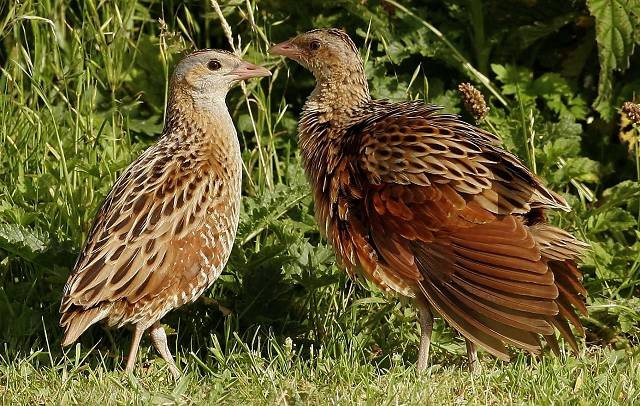Crex appear in fragile Corncrake recovery
The number of Corncrakes in their core Scottish strongholds declined in 2008 after years of sustained increase, with the unmistakeable 'crex' call of the male bird being heard less than last year. The Scottish Corncrake remains a conservation success story, but this year's decline highlights the importance of well-funded schemes to help farmers provide the valuable habitat that this shy little bird needs. The total core population of calling males dropped by just under 8% — from 1236 in 2007 to 1140 in 2008.

Corncrake, Balranald RSPB, N.Uist, Outer Hebrides (Photo:
Pauline Greenhalgh)
Corncrakes migrate to Scotland in late spring from sub-Saharan Africa, and spend the Scottish summer breeding in the tall grass and herbs that they use for cover. Since this type of habitat has largely disappeared from the mainland due to changes in agricultural practice, the charismatic little long-necked bird has found strongholds in the Hebridean and Argyll islands. Coll, Tiree, Iona, Colonsay, Oronsay and Islay, along with the Outer Hebrides, make up the vast majority of the UK population due to continuing traditional mixed grazing techniques by crofters and farmers.
Since 1993, when RSPB Scotland began a Corncrake recovery programme — working with farmers and crofters to produce Corncrake-friendly hay meadows and field margins — the population of calling males rose from just 446 in the UK core areas up to a high of 1236 in 2007. However the decline seen this year, though small, shows that there is no room for complacency.
Paul Walton, RSPB Scotland Species Policy Officer said, "The Corncrake management scheme has been a real Scottish conservation success story for the past 15 years. It was great that we were able to report increases year on year, as scientific lessons from studying the birds' decline were put into practice by farmers and crofters on the ground. However, the decline we've seen this year is worrying, and should serve as a warning to the Scottish Government that if we want to preserve these great wee birds then we need to ensure that there are sufficient funds available for targeted agri-environment options such as those that benefit Corncrake. The new Rural Priority scheme includes all the right ingredients. We must now work on ensuring good applications are being put forward and accepted."

Corncrake, Balranald RSPB, N.Uist, Outer Hebrides (Photo:
Mark Taylor)
Crofters and farmers can apply to the Scottish Government's Rural Development Contracts, which provide excellent land management incentives for Corncrake. Additionally, SNH runs a Corncrake management scheme which farmers can apply for in areas protected under EU law, and an additional RSPB, SNH and Scottish Crofting Foundation scheme makes payments available for those who cannot access the main schemes, but who have Corncrakes on their land. These schemes help farmers manage their hay or silage fields sensitively for Corncrakes, including waiting to cut the fields until after the main breeding season.
However, there is a real danger that species like Corncrake will suffer if funding for these environmentally beneficial forms of farming is not maintained or ideally, increased. Agri-environment funds need to be sufficiently large as well as accessible to farmers and crofters in the key Corncrake areas to allow the continuation of appropriate management.
The numbers of calling ('crexing') males heard in core areas each year are:

Corncrake calling males by year (Data: RSPB)

